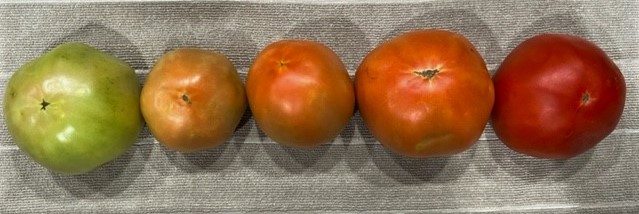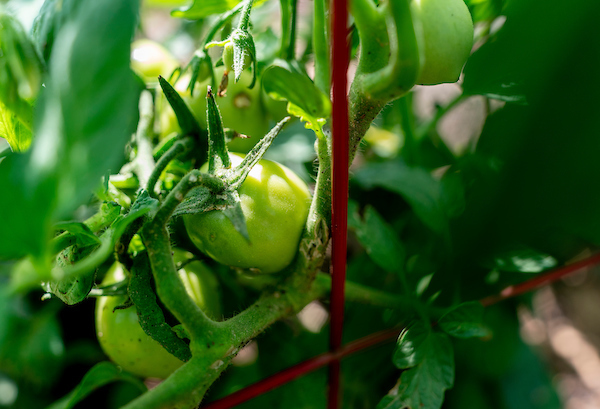Tips to keep tomatoes, from ‘breakers’ to ripened red
One of the simple joys of summer is access to great-tasting tomatoes.
Whether grown and picked at “color break” from a home garden or bought fully ripened at a local farmers market or grocery store, tomatoes are a treat.
There are some tips and tricks to help you get the most from your tomato harvest or purchase, according to a Texas A&M AgriLife Extension Service expert. Joe Masabni, Ph.D., AgriLife Extension small-acreage horticulturist at the Texas A&M AgriLife Research and Extension Center in Dallas and professor in the Department of Horticultural Sciences, shared his expert advice on storing and extending the life of tomatoes without compromising taste.
Timing is everything
Nothing will taste as great as a tomato at its peak, so timing is a major factor to consider when ripening tomatoes.
They can ripen in days or weeks, depending on the variety and stage at which they were picked, so buy or pick accordingly.
If all your tomato plants are full simultaneously and there is no possible way to eat them as fast as they need to be picked, there are ways to space out the ripening process to allow for extended use.
Any tomato reaching the “breaker stage” will continue to ripen off the vine, Masabni said. This is the stage where the bottom of the tomato has started to change from green to yellow.

The best place to let tomatoes ripen is on your kitchen counter. Ideally, ripe or ripening tomatoes prefer temperatures around the mid-60s, but Masabni said room temperature in most homes is fine.
However, breaker-stage tomatoes can be stored in a refrigerator to halt the ripening process. This allows you to pull them from the fridge and let them ripen as needed.
Once the tomatoes are at room temperature again, they will usually continue the ripening process over several days.
If you’ve picked an entirely green tomato, it will not ever ripen. It’s best to use these for a favorite recipe, like a relish or fried green tomatoes.
Vine ripening, or not

Once a tomato is at the breaker stage, it can be classified as vine ripened. Even though it doesn’t look ripe yet, it has all the sugars and essential compounds necessary for it to reach its mature color and full flavor.
“Once it’s physiologically ripe, it is considered vine ripened and can be picked and marketed as such,” Masabni said.
For gardeners, while it may seem like a good idea to keep the tomato on the vine until you are ready to eat it, the longer it is on the vine, the more likely it is to be eaten by birds or bugs.
If you can protect your tomato plants from pests that is best, but don’t have any qualms about picking your tomatoes and allowing them to finish ripening off the vine, because they will still have that same wonderful flavor.
Best way to store tomatoes
Make sure you store the tomatoes with a little space between them on the counter or in a container to allow air circulation, Masabni said.
“Tomatoes should be stored how you see them at the market – out in the open,” he said. “Consumers often do it wrong – they treat onions like tomatoes and tomatoes like onions when it comes to storage. Keep your onions in the refrigerator, not the counter or the pantry.”
Do not keep tomatoes in a closed bag unless you want to hasten the ripening process. Ethylene gas produced by tomatoes ripens them quicker when held in the bag.
Tomatoes will also ripen more quickly if left in warmer temperatures, like on a porch or in an outbuilding. This can happen quickly, so you’ll want to check on them daily in temperatures above 80 degrees.
Refrigeration can alter taste
As a rule of thumb, Masabni suggested not refrigerating ripe tomatoes whenever possible.
“Do not refrigerate ripe tomatoes unless you just can’t eat them,” Masabni said. “Refrigerators can affect the taste and texture of a ripe tomato, so let them ripen on a counter and then eat or cook with them.”
But for gardeners who have more than they can eat or share with friends and family, refrigeration is a way to extend the shelf life.
Let no tomato go to waste
If you have more tomatoes than you can eat, consider using them in salsa and other recipes. If they are just a little past their prime, they can also be turned into sauces.
Romas can be used to make tomato paste, but detecting if a Roma is still good is tough since they stay firm even after they go bad inside. Whole tomatoes may also be frozen to use in stews or cooked dishes.
“The only time a tomato is garbage is if it’s starting to be mushy,” he said.
PHOTO: Tomatoes picked too soon will not ripen, but can be used for fried green tomatoes. (Laura McKenzie/Texas A&M AgriLife)




